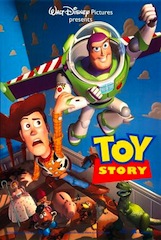 As the second decade of the digital cinema exhibition era progresses it’s a fitting time to consider the ten movies that played the most definitive role in moving the transition forward. Today, thanks to many factors – lower cost cameras and editing software, online fundraising, promotion and distribution – digitally made movies are quickly becoming standard. Digital technology has fueled the current Renaissance in documentary filmmaking. This was not the case just a few years ago and these are the movies that fueled the transition and helped revolutionize the motion picture industry: these are the ten most important films of the digital cinema era.
As the second decade of the digital cinema exhibition era progresses it’s a fitting time to consider the ten movies that played the most definitive role in moving the transition forward. Today, thanks to many factors – lower cost cameras and editing software, online fundraising, promotion and distribution – digitally made movies are quickly becoming standard. Digital technology has fueled the current Renaissance in documentary filmmaking. This was not the case just a few years ago and these are the movies that fueled the transition and helped revolutionize the motion picture industry: these are the ten most important films of the digital cinema era.
Half of these movies were independently made; half were made in stereographic 3D. Some were made with enormous budgets, while others had budgets that were very low. All but one of the ten made at least a modest profit, and most returned huge returns for their investors. All but one of them were critically acclaimed; one film started a national conversation that continues today and could well be an issue in the upcoming elections.
What may seem surprising to some is that the eight live-action movies – two were animated – used many different kinds (more than 20) on the same shoots. Only a handful used just one camera. Some were shot with among the highest-end cameras at the time their movie was made. Some were made with consumer cameras, some with DSLRs. That, and a growing number of digital formats, is becoming the norm for the digital cinema production world of the present and seems likely to only increase in the future. This is both a headache and a tremendous opportunity for post-production businesses as workflows become ever more complex. And it’s safe to predict that the industry will soon see an even larger choice of cameras and formats, as competing manufacturers develop tools for a growing range of acquisition demands. It is truer than ever before to say that there is now a specific camera choice for almost every production challenge.
Other than being well-made films, the movies I felt belonged on this list had to meet at least one of two basic criteria: did the movie advance the idea of digital acquisition and/or did it drive the digital cinema exhibition transition. In most cases, especially for the movies made after 2004, the answer to both was a resounding yes. Here then, in chronological order, are the ten most important films of the digital cinema era.
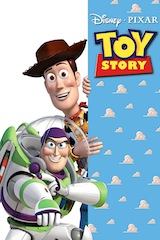 Toy Story 1995
Toy Story 1995
Budget: $30 million (estimated)
Box office: $358 million (worldwide)
Director: John Lassiter
Animated
Any list of important digital movies must include the first Toy Story, which not only introduced the world to the full magic of Pixar, and opened the door to the stereoscopic 3D boom that would blossom a decade later, it demonstrated that – when coupled with a powerful, inventive and well-told story – talented artists could use digital technology alone to create a masterpiece that the whole world would enjoy. For the professional creative community that possibility, of course, was accepted years before Toy Story with a long line of short masterpieces (some made by Pixar) that routinely received standing ovations at the annual SIGGRAPH convention every year. There were other, earlier attempts at feature-length digital films that incorporated digital technology – the first TRON comes to mind – but for the world at large, the possibilities of digital movie magic surely began with Toy Story.
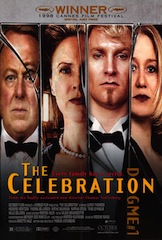 The Celebration 1998
The Celebration 1998
Budget: $1.3 million
Box office: $1.65 million (worldwide)
Director: Thomas Vinterberg
Cinematographer: Anthony Dod Mantle
Shot with: Sony DCR-PC-7E Handycam
The Celebration earned very little for its investors of all the films on this list and is one that deserved a much wider audience. It’s more widely recognized claim to fame is that it was the first movie to come out of the Dogme 95 film movement. (Its full title in Denmark is Dogme #1 – Festen). Dogme films were governed by a manifesto that insisted on specific production and narrative limitations (such as banning any post-production sound editing), in part as a protest against expensive Hollywood-style filmmaking and gave way to the more recent Mumblecore movement. But this movie is much more than just a political statement about production aesthetics. The Celebration is beautifully written and acted and beautifully made. The small camera and limited gear gave the cast and crew a freedom of movement unheard of with often cumbersome film production packages and crews. Yes, the low production values are evident and the movie has a noticeable washed-out look but as you’re watching the movie you quickly forget any technical issues because after the first few minutes all that matters is following what happens to this family as it undergoes a truly life-changing experience.
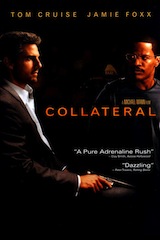 Collateral 2004
Collateral 2004
Budget: $65 million
Box office: $208 (worldwide)
Director: Michael Mann
Cinematographer: Paul Cameron
Shot with: PanArri 435, Panavision Primo Lenses / Panavision Panaflex Millennium XL, Panavision Primo Lenses / Panavision Panaflex Millennium, Panavision Primo Lenses / Sony CineAlta HDW-F900, Zeiss DigiPrime Lenses / Thomson Viper FilmStream Camera, Zeiss DigiPrime
Collateral was the first feature length film that was praised by major film critics not despite the fact that it was shot digitally but rather because it was shot in HD. Prior to Collateral, the typical movie review lamented the harsh, artificial look of digitally shot movies. Many cinematographers I know criticized what they saw as muddiness in the shadow details but most critics were thrilled with the way that digital cinematography made Los Angeles at night look exactly as it is. To take just one example, in her highly favorable New York Times review Manohla Dargis wrote, “Collateral is very much the product of a distinct vision, one as eager to push technological limits (the film was shot with the most advanced video cameras) as to upend the usual studio white-hero/black-villain formula.” The movie featured an all-too rare great performance by Tom Cruise and showed Jamie Foxx playing against what was, in that era, supposedly his type. For the first time, Collateral showed that a major movie shot digitally could perform well at the box office. Clearly, audiences didn’t notice, didn’t mind the so-called harsh digital look and many actually liked it.
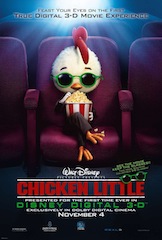 Chicken Little 3D 2005
Chicken Little 3D 2005
Budget: $150 million
Box office: $298 million (worldwide)
Director: Mark Dindal
Animated
Chicken Little 3D is the only movie on this list that received largely negative reviews. Richard Roeper, then of the Ebert & Roeper television show, panned the movie in his review when it first opened saying, "I don't care whether the film is 2D, 3D, CGI, or hand-drawn, it all goes back to the story." And yet Chicken Little 3D, as much as any film on this list, deserves inclusion. It was the first all-digital 3D movie from Disney and the first mainstream family film to get widespread release in digital 3D, even though in 2005 “widespread digital 3D release” meant fewer than 100 screens. The negative reviews didn’t matter and neither did the fact that theatres charged a large premium to see it in 3D. Some theatres charged more than double – a few much more – and audiences didn’t care. The movie made virtually as much money from that handful of 3D screens as it did on the 2D screens. That Hollywood misinterpreted the Chicken Little 3D lesson and has spent the intervening years converting a host of bad movies into 3D so they could charge more is not entirely the fault of one movie. The Hollywood studios have a history of such moves. The curiosity factor has dimmed from the days of when a movie like Pixar’s 2009 gem Up was so popular that some 2D theatres remained empty if it was playing on a 3D screen in the same building. When a movie has a great story with compelling characters and the 3D is done well, audiences still seem to prefer 3D versions and, despite it flaws Chicken Little 3D was first.
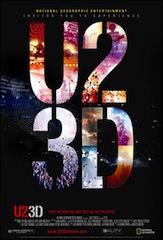 U23D 2008
U23D 2008
Budget: $964,000
Box office: $12.4 million (worldwide)
Director: Catherine Owens
Cinematographer: Tom Krueger
Shot with: 3ality TS 1 / Fusion 3D Camera Systems / Hineslab Stereocam / Sony CineAlta HDC-F950, Zeiss DigiZoom Lenses
Catherine Owens, a talented visual artist who had never made a feature film let alone one in stereoscopic 3D, directed the concert film U23D. Designed specifically for theatrical release, in addition to being a thoroughly well made and entertaining movie, it demonstrated to the production community that the tools needed to handle any conceivable shot in a movie were available now. If in some ways the film was an expensive advertisement for its makers, then called 3ality and today 3ality Technica, it was an even bigger endorsement for the full possibilities of digital 3D when handled by professionals. In every way it showed the creative community that now they could work in an entirely new, immersive way.
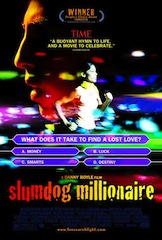 Slumdog Millionaire 2008
Slumdog Millionaire 2008
Budget: $15 million (estimated)
Box office: $362 million (worldwide)
Director: Danny Boyle
Cinematographer: Anthony Dod Mantle
Shot with: Arricam LT, Zeiss and Angenieux Lenses / Arricam ST, Zeiss and Angenieux Lenses / Arriflex 235, Zeiss and Angenieux Lenses / Arriflex 35 BL4, Zeiss and Angenieux Lenses / Canon EOS-1D Mark III / Silicon Imaging SI-2K MINI, Zeiss, Angenieux, Century, Canon, Cooke and Linos Lenses
Phenomena are not uncommon in the motion picture business and Slumdog Millionaire was certainly all of that. Made for a modest budget and shot in large part in documentary style on the gritty streets of Mumbai with a wide variety of cameras and lenses, its classic boy-meets-girl story and its charismatic young stars captured the imagination and hearts of audiences worldwide. Digital cinematography pioneer Anthony Dod Mantle shot the movie and in doing so captured the Oscar and to a very large degree helped validate once and for all the idea that in the right hands digital technology was not simply a choice, often it was the best choice. As evidence of this, consider that Dod Mantle’s latest work, on Ron Howard’s Rush, and shot exclusively with Canon digital cinema cameras and lenses recently opened to widespread audience and critical acclaim.
![]() Avatar 3D 2009
Avatar 3D 2009
Budget: $237 million (estimated)
Box office: $2.78 billion (worldwide)
Director: James Cameron
Cinematographer: Mauro Fioro
Shot with: PACE Fusion 3-D / Sony CineAlta F23, Canon and Fujinon Lenses / Sony CineAlta HDC-1500, Canon and Fujinon Lenses / Sony CineAlta HDC-F950, Canon and Fujinon Lenses
Avatar may be the most expensive and most successful personal movie ever made. Not that it represented, in that regard, anything different for director James Cameron, whose previous films included Titanic (until Avatar the box-office champion) and Terminator 2, which significantly raised the bar for digital effects. Given the overall success of stereoscopic 3D movies in theatres today, it’s easy to forget the nervousness that pervaded the motion picture industry in the months leading up to Avatar’s release. No matter what your views on 3D’s future as a creative choice or a long-term business, a lot was riding on Cameron’s efforts. That the Hollywood studios interpreted the results poorly yet again is not the fault of Avatar. Studios failed to take seriously the importance of the huge budget and the talents of Cameron and his cast and crew and continue to release a seemingly endless stream of hastily made and underfunded 3D films with sadly mixed results. All Cameron did was take years to carefully make a movie that people all around the world loved and admired.
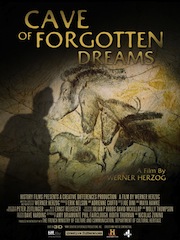 Cave of Forgotten Dreams 3D 2010
Cave of Forgotten Dreams 3D 2010
Budget: $139,000
Box office: $6.47 million (worldwide)
Director: Werner Herzog
Cinematographer: Ernst Reijseger
Shot with: According to an article in the Los Angeles Times, the 3D cameras were custom-built for the production, and were often assembled inside the cave itself.
Of the films I’ve seen, Cave of Forgotten Dreams is the first and only one that quite literally could not have succeeded were it not shot in digital stereoscopic 3D. As Herzog, who has reportedly vowed never to shoot a 3D movie again, explains throughout his narration of the film, the filmmakers were severely limited both on the amount of time they could spend in the caves each day and on the amount of production gear and crew they could use: the caves where the paintings can be found are simply too narrow for more than a handful of people to visit at one time and too fragile for extreme movie lights. But 3D was the only way to really capture the magnificent art that curves around rock walls and uses crevices as design elements. Despite the many restrictions – indeed in many ways because of them – Herzog has created a rich, warm, fascinating film that truly shows the breathtaking beauty of art created tens of thousands of years ago. Without 3D, these historic paintings could not have been revealed in all their glory.
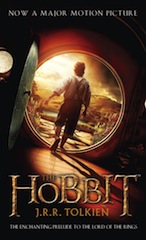 The Hobbit: An Unexpected Journey HFR 3D 2012
The Hobbit: An Unexpected Journey HFR 3D 2012
Budget: $180 million (estimated)
Box office: $1.02 billion (worldwide)
Director: Peter Jackson
Cinematographer: Andrew Lesnie
Shot with: Red Epic, Zeiss Ultra Prime and Angenieux Optimo Lenses
The fact that the first Hobbit movie failed for me does nothing to diminish the fact that it belongs on this list. Many critics shared my view that, among other things, the film was an hour-and-a-half or less of story stretched into almost double that. Still, it belongs on this list because history will record that it was the first feature film shot at 48 frames a second and not the more standard 24 or 30 fps. Peter Jackson’s work in that regard has proven to be very controversial in the industry. In fairness, very few people have so far embraced the idea of shooting with higher frame rates but advocates make the case that it has great value, in particular in 3D because the technique can eliminate motion blur and greatly adds the amount of information and brightness that can be projected on a screen. Many people privately and a few publically feel that, at the very least, the new technique added nothing to the Hobbit. Some believe it was a detriment. Regardless of the controversy in the industry Hobbit fans embraced the movie with open arms and wallets and there is no doubt that the HFR era has begun.
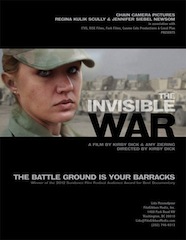 The Invisible War 2012
The Invisible War 2012
Budget: $850,000
Box office: $71,968
Director: Kirby Dick
Cinematographers: Kirsten Johnson, Thaddeus Wadleigh
Shot with: Canon D5, Sony Z1
The Invisible War is the consummate digital movie and just one of the latest and most successful examples of the current and ongoing Renaissance in documentary filmmaking. The makers of The Invisible War discovered their topic in an online article, arranged and organized interviews using Facebook and raised their funding largely through Kickstarter. The movie was screened in three digital formats HDCam, Blu-Ray and DCP. That the movie was not a financial success, not uncommon in the documentary world, is unfortunate and beside the point. Prior to The Invisible War, the world was not aware of just how many U.S. soldiers (women and men) are sexually assaulted and how poorly the military establishment has responded to the situation. The movie premiered at the 2012 Sundance Film Festival where it was named Best U.S. Documentary. It went on to secure many other awards and recognition including a nomination for the Academy Award for Best Feature-Length Documentary. Most importantly, it significantly changed the national conversation about a very serious topic. That conversation continues today, is gaining momentum following The Invisible War’s recent screening on PBS and is certain to be an issue in the 2014 U.S. elections.
